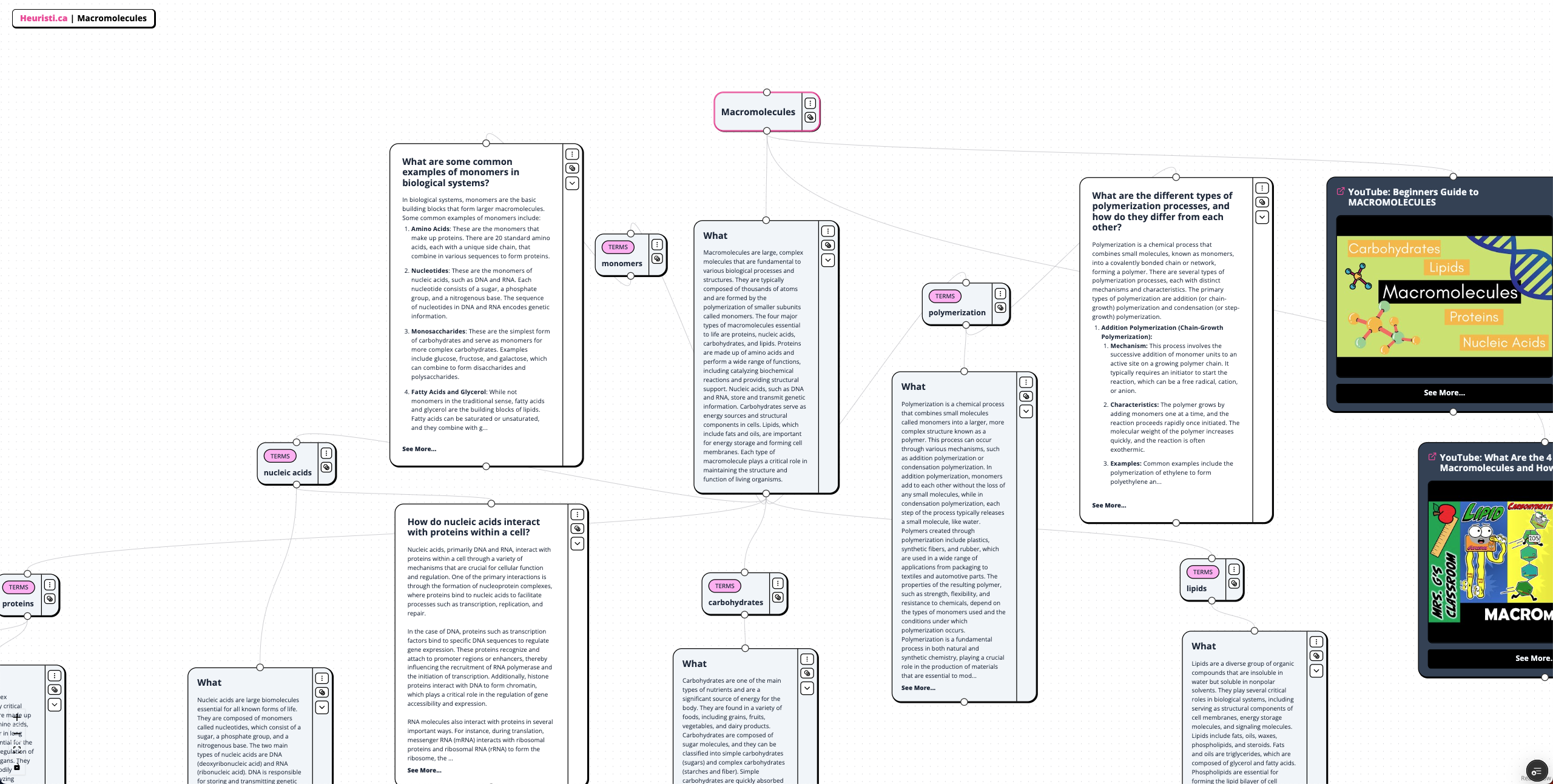Macromolecules Concept Map

Summary
Macromolecules are large, complex molecules essential for various biological processes and structures, typically composed of thousands of atoms formed by the polymerization of smaller subunits called monomers. The four major types of macromolecules vital to life are proteins, nucleic acids, carbohydrates, and lipids.
Proteins
Proteins are made up of amino acids and perform a wide range of functions, including catalyzing biochemical reactions and providing structural support. They are crucial for the immune response, forming antibodies and facilitating communication between immune cells through signaling proteins.
Nucleic Acids
Nucleic acids, such as DNA and RNA, are composed of nucleotides and are responsible for storing and transmitting genetic information. They interact with proteins to regulate gene expression and are essential for processes like transcription and translation.
Carbohydrates
Carbohydrates serve as energy sources and structural components in cells. They can be classified into simple carbohydrates (sugars) and complex carbohydrates (starches and fiber), with complex carbohydrates providing a more sustained energy release.
Lipids
Lipids are a diverse group of organic compounds that are insoluble in water but soluble in nonpolar solvents. They play critical roles in energy storage, forming cell membranes, and serving as signaling molecules. Key types of lipids include triglycerides, phospholipids, and steroids.
Cholesterol
Cholesterol, a type of lipid, is essential for hormone production and digestion. It exists in two forms: low-density lipoprotein (LDL), known as "bad" cholesterol, and high-density lipoprotein (HDL), known as "good" cholesterol. Maintaining a healthy balance between these types is crucial for cardiovascular health.
Polymerization
Polymerization is the process that combines monomers into polymers. It can occur through addition or condensation mechanisms, leading to various materials used in everyday applications. Understanding polymerization is fundamental in both natural and synthetic chemistry.
Monomers
Monomers are the basic building blocks of macromolecules. Examples include amino acids for proteins, nucleotides for nucleic acids, monosaccharides for carbohydrates, and fatty acids and glycerol for lipids. These monomers are essential for the structure and function of cells.
Key Takeaways
- They are formed by the polymerization of smaller subunits called monomers.
- The four major types of macromolecules are proteins, nucleic acids, carbohydrates, and lipids.
- Proteins are made of amino acids and perform various functions, including catalyzing reactions and providing structural support.
- Nucleic acids, such as DNA and RNA, store and transmit genetic information.
- Carbohydrates serve as energy sources and structural components in cells.
- Lipids are important for energy storage and forming cell membranes.
- Lipids include fats, oils, waxes, phospholipids, and steroids.
- Cholesterol is a type of lipid essential for hormone production and digestion.
- LDL (Low-Density Lipoprotein) is known as "bad" cholesterol, while HDL (High-Density Lipoprotein) is referred to as "good" cholesterol.
- Steroids are organic compounds that include hormones and vitamins, playing roles in metabolism and immune response.
- Triglycerides are the most common type of fat in the body, used for energy storage.
- Phospholipids are major components of cell membranes, forming lipid bilayers.
- Carbohydrates can be classified into simple and complex carbohydrates, with complex carbohydrates providing sustained energy.
- Nucleic acids are composed of nucleotides and are vital for processes like replication and transcription.
- Proteins are crucial for the immune response, forming antibodies and facilitating communication between immune cells.
- Polymerization is the process of combining monomers to form polymers, with addition and condensation as primary types.
- Monomers include amino acids, nucleotides, monosaccharides, and fatty acids, which are essential for forming macromolecules.
Additional Concepts
Questions and Answers
What are macromolecules?
What is polymerization?
What are proteins?
What are nucleic acids?
What are carbohydrates?
What are lipids?
What is cholesterol?
Flashcards
What are macromolecules?
Macromolecules are large, complex molecules that are fundamental to various biological processes and structures, typically composed of thousands of atoms formed by the polymerization of smaller subunits called monomers.
What are the four major types of macromolecules essential to life?
The four major types of macromolecules essential to life are proteins, nucleic acids, carbohydrates, and lipids.
What is polymerization?
Polymerization is a chemical process that combines small molecules called monomers into a larger, more complex structure known as a polymer.
What are proteins made of?
Proteins are made up of amino acids, which are linked together in long chains.
What role do nucleic acids play in living organisms?
Nucleic acids, such as DNA and RNA, store and transmit genetic information and are essential for processes like replication and protein synthesis.
What are lipids and their functions?
Lipids are a diverse group of organic compounds that are insoluble in water and serve critical roles such as energy storage, forming cell membranes, and acting as signaling molecules.
What is the difference between LDL and HDL cholesterol?
LDL stands for Low-Density Lipoprotein, often referred to as 'bad' cholesterol, which can lead to plaque buildup in arteries, while HDL stands for High-Density Lipoprotein, known as 'good' cholesterol, which helps remove other forms of cholesterol from the bloodstream.
What are triglycerides?
Triglycerides are a type of fat found in the blood, used for energy, and high levels can increase the risk of heart disease.
What are phospholipids and their role in cells?
Phospholipids are a class of lipids that are a major component of cell membranes, forming lipid bilayers that provide barriers and facilitate cellular processes.